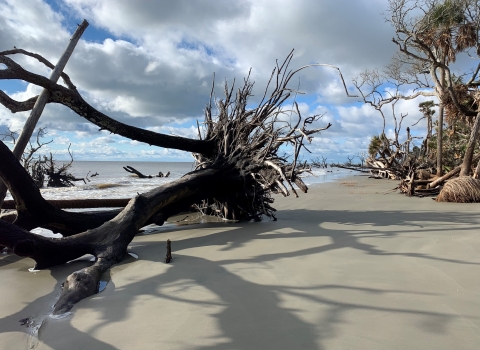Our northern Saskatchewan waterfowl banding team, comprised of three dedicated USFWS wildlife biologists, put forth a valiant effort to capture and band as many waterfowl as possible. With mallards as the primary target species, we took meticulous care to select sites and deploy traps. Despite facing challenges such as low water levels, vast expanses of wild rice in full production, warm weather, and thick, acrid smoke from surrounding wildfires, our intrepid team persevered.
After careful scouting and trap deployment, we settled into a daily routine. Each day began with the eerie call of loons in the morning mist—though in reality, the “mist” was morning smoke. After a quick but hearty camp breakfast, we would mount up on our boreal marsh chariot, a 15-year-old airboat affectionately nicknamed “El Toro” for its resemblance to a mechanical bucking bull as it navigated the vast swells of the boreal lake. Initially, the traps produced slow results, but they began to catch ducks consistently despite lower than average numbers of waterfowl observed in the area.
Perhaps most gratifying to us was the composition of mallards to other species in the traps. Although the total number of captures was lower than expected, we were pleased that the majority were indeed mallards. Enduring the thick smoke and relying on 24-hour allergy meds to keep our airways open suddenly felt worth it! A close second on the list of “most pleasing” benefits was the ample bounty of wild blueberries, which resulted in delectable daily desserts of blueberry tarts, breads, biscuits, and pancakes.
Scenes of white pelicans bouncing on the lake, scores of double-crested cormorants passing through, and bald eagles at every turn kept team morale high. Gray jays and black-capped chickadees visiting the camp motivated us to hang a small bird feeder, as bird nerds are inclined to do! Moose and bear sightings also kept us entertained, with one crew member seeing her first moose after many trips to the boreal. Though, to be honest, the sight of a very large bear in camp made midnight trips to the outhouse a bit more unsettling. Thankfully, the resident canine, “Bonnie,” did her best to keep up a regular patrol around camp.
At the end of each day we enjoyed camp dinners and good conversation. Although hopes of seeing the northern lights were dashed by the thick smoke, it was probably for the best, as we were all exhausted and most nights hit the bedroll before it was even fully dark. With 368 ducks banded, our team, despite wishing for more, felt satisfied with our overall effort and success given the obstacles they faced.








